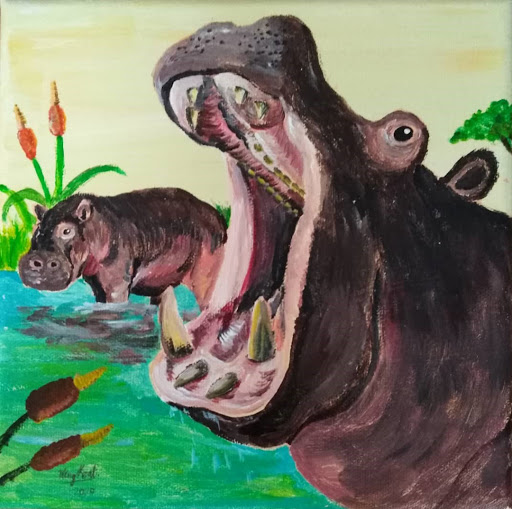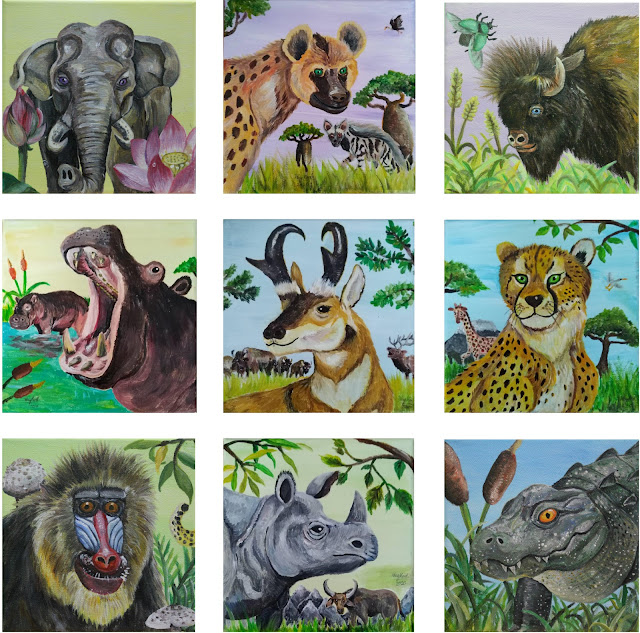Collection: Majestic Menagerie II
MAJESTIC MENAGERIE II
A menagerie can be defined as a collection of exotic and unique animals, and the term also refers to a precursor to modern zoos which also showcases exotic animals. In the 18th century, the term menagerie is used for animal collections by aristocrats or royals who seek to display their power and wealth because exotic animals are quite difficult to acquire and harder to maintain. The natural world, however, had a vast collection of diverse life which can be considered unique in their own ways.
American Alligator
 |
| American Alligator, acrylic on canvas, 2020 |
The American alligator (Alligator mississippiensis) differs from most crocodilians in having a shorter, rounded snout and the teeth on the lower jaw being hidden when the animal’s mouth is closed. They inhabit swamps, streams, rivers, ponds, and lakes in the southeastern United States.
Elephant
 |
| Elephant and Lotus, acrylic on canvas, 2020 |
The Asian elephant (Elephas maximus) plays a significant role in the cultures of southern and southeast Asian cultures, especially India and Thailand. Sometimes, they are also revered as deities and sacred animals. In Buddhist culture, the elephant is depicted as a symbol of royalty and authority.
Wood Bison
 |
| Bison, acrylic on canvas, 2020 |
The wood bison (Bison bison athabascae) is a species of cattle that roams the forests and mountains of North America. It is slightly larger in comparison to the plains bison which also lives in North America. They are known for their dark brown fur coat that keeps them warm during cold temperatures.
Mandrill
 |
| Mandrill B, acrylic on canvas, 2020 |
The mandrill (Mandrillus sphinx) is the world’s largest and heaviest monkey. They live in tropical rainforests in very large groups and are commonly found in the western equatorial coast of Africa.
Indian Rhinoceros
 |
| Indian Rhinoceros, acrylic on canvas, 2020 |
The Indian rhinoceros (Rhinoceros unicornis) lives in the Indian subcontinent and has one horn on its nose. It feeds by grazing on grasses and browsing on leaves on shrubs and trees. This species is one of the first to be described and is very popularly depicted in ancient works from India and China.
Cheetah
 |
| Cheetah, acrylic on canvas, 2020 |
Having a lightly-built body and slender limbs, the cheetah is the fastest-running animal on land, being able to burst into speeds of more than 100 kilometres per hour. It is one of the three big cats that roam the grasslands of Africa, beside the lion and leopard.
Hippopotamus
 |
| Yawning Hippo, acrylic on canvas, 2020 |
The hippopotamus (better known as hippo) is one of the heaviest mammals to live an amphibious lifestyle, which is in both the land and the water. Hippos are generally powerful herbivores which feed on submerged plants. Their mouths can open to almost 180 degrees, revealing large canine tusks which are used in combat.
Hyena
 |
| Hyenas, acrylic on canvas, 2020 |
There are four members of the hyena family, and two are featured on the painting: the spotted hyena and the striped hyena (in the background). The two species' ranges overlap each other in the African continent, but only striped hyenas also live in western and southern Asia and the Middle East. These hyenas are well-known to be scavengers which feed mainly on carcasses.
Pronghorn
 |
| Pronghorn, acrylic on canvas, 2020 |
The pronghorn (Antilocapra americana) is one very unique mammal: it resembles an antelope but its closest cousins are giraffes. It lives in the plains of North America and is the fastest herbivorous mammal on Earth. It also has excellent eyesight.




Comments
Post a Comment